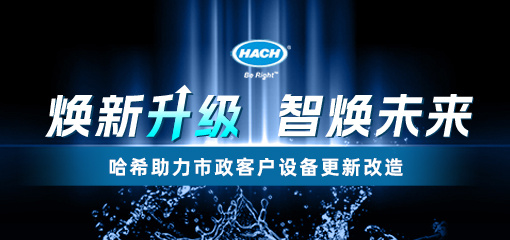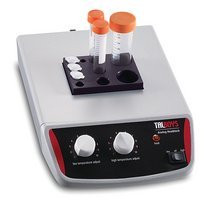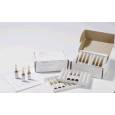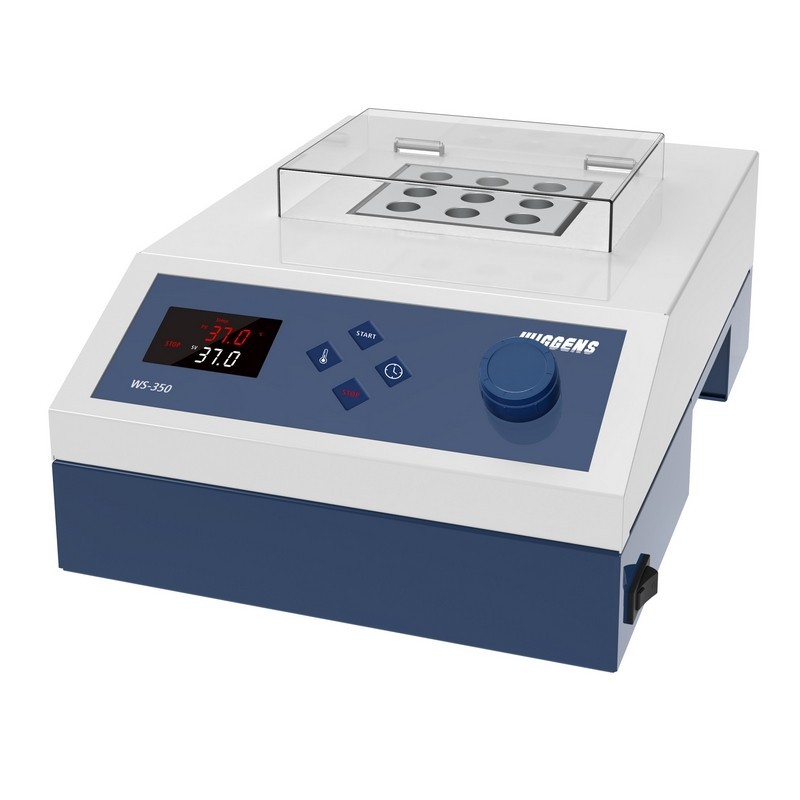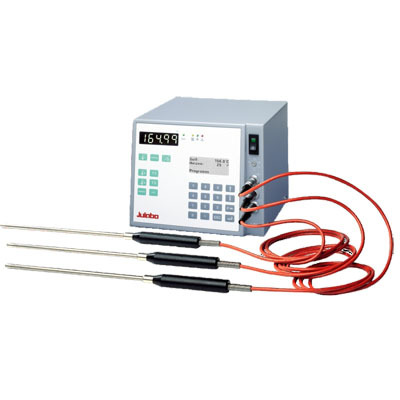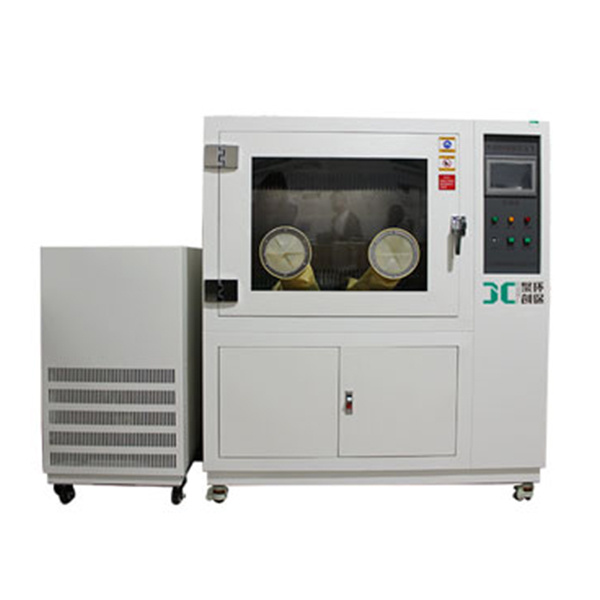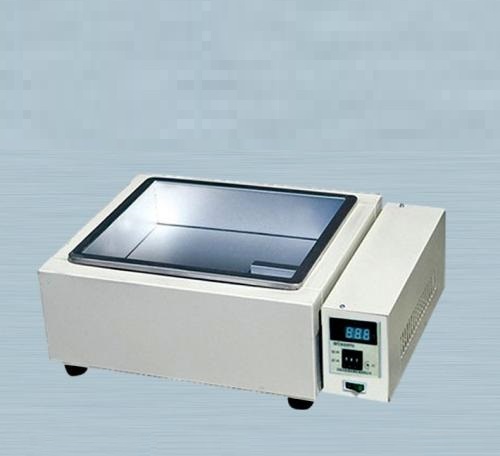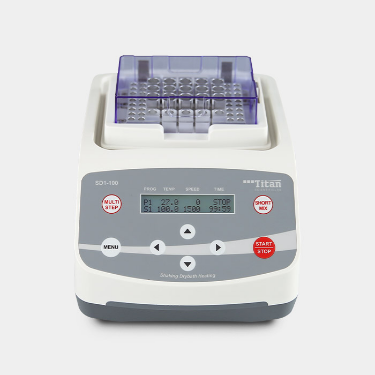离子液体是一类具有低熔点的有机阳离子与无机/有机阴离子的共聚体。因其几项独特的性质而使其成为具有价值的气相色谱固定相。2005年,美国德克萨斯大学的Daniel,W.Armstrong教授提出了以双阳离子聚合阴离子液体为固定相的技术,Supelco于2008年将此技术变成现实并成功推出商业化的离子液体毛细管色谱柱。
Sigma-aldrich旗下子品牌Supelco自2008年首次推出商业化的离子液体色谱柱SLB-IL100以来,目前为止一共有6款离子液体色谱柱可供选择。值得注意的是传统色谱柱随极性的增加耐温极性也受到局限,而超强极性的离子液体色谱柱则不受这一规律的束缚。SLB-IL111耐温270度。
本文对脂肪酸甲酯的分析,采用SLB-IL111,其效果优于SP-2560。且对于某些SP-2560较难分析的同分异构体,也显示出非常好的效果。
方案详情

SIGMA-ALDRICHsigma-aldrich.comTel: (800) 247-6628 (814)359-3441Fax: (800) 447-3044 (814) 359-3044Technical Report 595 North Harrison Road, Bellefonte, PA 16823-0048 USA SLB-IL111 for Fatty Acid Methyl Ester (FAME) Applications Michael D.Buchanan, Katherine K. Stenerson, and Leonard M. Sidisky The extremely polar SLBM-IL111 columnexhibits the highest polarity of any GCphase, allowing it to resolve key cis/transfatty acid methyl ester (FAME) isomers thatcannot be resolved on other columns. Italso provides an alternative selectivity forFAME applications typically performed onhighly polar cyanopropyl siloxane columns.Its maximum temperature of 270℃ is veryimpressive for such an extremely polar column. The chromatograms shown here demonstrate the utility of theSLB-IL111 as a great column choice for the analysis of FAMEs. Fatty Acid Chemistry The most commonly analyzed fatty acids consist of C4-C24+hydrocarbon chains with a carboxyl group (-COOH) at one end. Manytypes of fatty acids exist, including: Saturated = all single bonds between carbon atoms. ●Unsaturated=at least one double bond. Polyunsaturated= at least two double bonds. cis = bonds on either side of the double bond are on the same side. ●trans = bonds on either side of the double bond are on opposite sides. p(Omega 3 = initial double bond located directly after the third carbonatom as measured from the methyl end. .Omega 6= initial double bond located directly after the sixth carbonatom as measured from the methyl end. It is important for food manufacturers to report the levels of each type offatty acid, as each has known or suspected health effects. Figure 1 showsthe structures of several varieties of fatty acids. Figure 1. Fatty Acid Structures Derivatization of Fatty Acids to Methyl Esters GC can be used to analyze fatty acids, either as free fatty acids or as fattyacid methyl esters. The primary reasons to analyze fatty acids as fatty acidmethyl esters include: ● In their free, underivatized form, fatty acids may be difficult to analyze,because these highly polar compounds tend to form hydrogen bonds,leading to adsorption issues. Reducing their polarity may make themmore amenable for analysis. ● To distinguish between the very slight differences exhibited byunsaturated fatty acids, the polar carboxyl functional groups mustfirst be neutralized. This then allows column chemistry to performseparations by degree of unsaturation, position of unsaturation, andeven the cis vs. trans configuration of unsaturation. The esterification of fatty acids to FAMEs is performed using an alkylationderivatization reagent. Methyl esters offer excellent stability, and providequick and quantitative samples for GC analysis. As shown in Table 1, theesterification reaction involves the condensation of the carboxyl groupof the fatty acid and the hydroxyl group of an alcohol. Esterificationis best done in the presence of an acidic catalyst (such as borontrichloride). The catalyst protonates the oxygen atom of the carboxylgroup, making the acid much more reactive. Nucleophilic attack byan alcohol then yields an ester with the loss of water. The catalyst isremoved with the water. The alcohol used determines the alkyl chainlength of the resulting esters; the use of methanol will result in theformation of methyl esters whereas the use of ethanol will result in ethylesters.(1,2) Table 1. Typical Esterification Procedure 1. Weigh 1-25 mg of sample into a 5-10 mL Micro Reaction Vessel. 2. Add 2 mL BCl-Methanol, 12% w/w. Awater scavenger (such as2,2-dimethoxypropane) can be added at this point. 3. IHeat at 60℃ for 5-10 minutes. Derivatization times may vary,depending on the specific compound(s) being derivatized. 4. Cool,then add 1 mL water and 1 mL hexane. Shake the reaction vessel (it is critical to get the esters into the non-polar solvent). b.After allowing the layers to settle, carefully transfer the upper (organic)layer to a clean vial. Dry the organic layer either by passing through abed of anhydrous sodium sulfate during the transfer step to the cleanvial, or by adding anhydrous sodium sulfate to the clean vial and thenshaking. GC Column Polarity Scale A visual depiction of our GC column polarity scale is shown in Figure 2,showing the relationship of several columns to one another. Thepositions/maximum temperatures of several non-ionic liquid capillaryGC columns are shown to the left of the scale. Listed to the right of thescale are the positions/maximum temperatures of Supelco° ionic liquidcapillary GC columns.All polarity number values are relative to bothsqualane (0 on the scale) and SLB-IL100 (100 on the scale). This simplebut useful scale allows multiple columns to be quickly compared.Detailed information concerning the scientific basis used to generatethis scale can be found at sigma-aldrich.com/il-gc Figure 2. GC Column Polarity Scale, Positions/MaximumTemperatures of Columns Standard:37-Component FAME Mix To properly identify fatty acid composition, standards of known referencemust be used. One such standard is the Supelco 37-Component FAMEMix (47885-U). This standard contains methyl esters of fatty acids rangingfrom C4 to C24, including key monounsaturated and polyunsaturatedfatty acids; making this standard very useful to food analysts since it canbe used to identify fatty acids in many different types of foods. This mixwas analyzed on the SPTM-2560, a popular cyanopropyl siloxane column,and the SLB-IL111. Optimized chromatograms are shown in Figure 3. Observations are: ●Baseline and Peak Shape. Both columns produced chromatogramswith minimal bleed and sharp peaks. Signal-to-noise ratios for the latereluting peaks are slightly better with the SLB-IL111 column. ● Run Time. Dispersive interaction is weaker on the SLB-IL111; therefore,overall analysis time is shorter than on the SP-2560 (22 minutescompared to 26 minutes). ● Selectivity.Dipole-induced dipole interactions are stronger on theSLB-IL111 than on the SP-2560. These interactions result in increasedretention of polarizable analytes (those with double bonds) relative tonon-polarizable analytes. In fact, the higher the degree of unsaturation(the greater the number of double bonds), the stronger the retentionis. Overall, this results in alternative selectivity to the SP-2560. Acomparison of elution orders and elution locations are summarized inTable 2 and Table 3, respectively. Table 2. Comparison of Elution Orders Peak ID Isomer SP-2560* SLB-IL111* C18:2n6c C18:0 C20:0 C18:3n6 C20:0 C21:0 C18:3n3 C20:0 C21:0 C20:2 C21:0 C22:0 C20:3n6 C22:0 C23:0 C20:3n3 C22:0 C23:0 C22:2 C23:0 C24:0 *On this column, this isomer elutes after this saturated FAME. Table 3. Comparison of Elution Locations Peak ID Isomer SP-2560 SLB-IL111 C20:4n6 Right after C23:0 Right before C24:0 C20:5n3 Right after C24:0 >1 min. after C24:0 C22:1n9 Between C22:0 and C23:0 Right before C23:0 C22:6n3 ~2.5 min. after C24:0 ~3.2 min. after C24:0 det.: FID,260℃ All other conditions the same as those used for the SP-2560 1. Butyric Acid Methyl Ester (C4:0) at 4 wt % 10. Pentadecanoic Acid Methyl Ester (C15:0) at 2 wt% 11. cis-10-Pentadecenoic Acid Methyl Ester (C15:1) at 2 wt % 12. Palmitic Acid Methyl Ester (C16:0) at 6 wt % 13. Palmitoleic Acid Methyl Ester (C16:1) at 2 wt % 14. Heptadecanoic Acid Methyl Ester (C17:0) at 2 wt % 15. cis-10-Heptadecenoic Acid Methyl Ester (C17:1) at 2 wt % 16. Stearic Acid Methyl Ester (C18:0) at 4 wt% 17. Oleic Acid Methyl Ester (C18:1n9c) at 4 wt % 18. Elaidic Acid Methyl Ester (C18:1n9t) at 2 wt % ( 1 9. L inoleic Acid M ethyl Ester (C1 8 :2n6c) at 2 wt % ) ( 20. L i n olelaidic Acid Methyl Ester (C18:2n6t) at 2 wt % ) ( 21. y-Linolenic Acid Methyl Ester (C18:3n6) at 2 wt% ) ( 22. a -Linolenic Acid M e thyl Ester (C18 : 3n3) at 2 wt % ) ( 2 3. Arachidic Acid Methyl Ester (C20:0 ) at 4 wt% ) ( 24. cis-11-Eicosenoic Acid Methyl E ster (C20:1n9) at 2wt % ) 25. cis-11,14-Eicosadienoic Acid Methyl Ester (C20:2) at 2 wt% ( 26. c is-8,11,14-Eicosatrienoic Acid M ethyl Ester (C20:3n6) at 2 wt% ) ( 27. c is-1 1 ,14,17-Eicosatrienoic Acid Methyl Ester (C20:3n3) at 2 wt % ) ( 28. A rachidonic Acid Methyl Ester (C20:4n6) at 2 wt % ) ( 2 9. c is-5,8,11,14,17- E icosapentaenoic Acid Me t hyl Ester ( C20:5n3) at 2 wt% ) ( 3 0. H eneicosanoic Acid Methyl Ester (C21:0) at 2 wt% ) 31. Behenic Acid Methyl Ester (C22:0) at 4wt% ( 32. E rucic Acid M ethyl Ester (C22:1 n 9) at 2 wt% ) ( 3 3. c is-13,16-Docosadienoic Acid Methyl Ester (C22:2) at 2 wt % ) ( 34. cis-4,7,10,13,16,19-Docosahexaenoic Acid Methyl Ester ( C22:6n3) at 2 wt% ) 35. Tricosanoic Acid Methyl Ester (C23:0) at 2wt % ( 36. L ignoceric Acid Methyl Ester (C24:0) at 4 wt % ) ( 37. Nervonic Acid Methyl Ester (C24:1n9) at 2 wt % ) SLB-IL111 Application: Trans Fats Fatty acids in the cis configuration are the dominant form in nature.Correspondingly,enzymes have evolved to efficiently digest andmetabolize them with a high degree of specificity. Conversely, transfatty acids are relatively rare in nature. However, they have becomepredominant synthetic additives to processed foods, especially friedfoods and baked goods, because they can increase the shelf life andflavor stability of foods containing them. It is now known that transfatty acids, formed by partial hydrogenation of vegetable oil, interferewith natural metabolic process. Studies have linked their nutritionalcontribution to be similar to that of saturated fatty acids, possiblyplaying a role in the heightened risk of coronary artery disease. (3-5)Because of this, consumer groups have pressured manufacturers andrestaurants for the elimination of trans fats. Many regulatory agenciesworldwide now require content labeling, to inform buyers of'trans fat'levels of foods and some dietary supplements. The analysis of nutritionally significant C18 cis and trans fatty acids,as their methyl esters requires the use of a highly polar column toresolve the geometric positional isomers. The 100 m SP-2560 column isextremely useful for this type of analysis. Based on the results seen withanalysis of the 37-component FAME mix, the SLB-IL111 was expectedto offer selectivity for this application that is complementary to the SP-2560. To compare the two columns, a partially hydrogenated vegetableoil (PHVO) sample containing various C18:1 geometric positional isomerswas analyzed on both. The PHVO extract was graciously provided by Dr.Pierluigi Delmonte at the United States Food and Drug Administration(US FDA). A trans fraction extract and a cis fraction extract, both preparedfrom PHVO using an Ag-ion fractionation procedure, were also suppliedby Dr. Delmonte.The PHVO extract contains thirteen C18:1 trans FAMEisomers (from C18:1A4t to C18:1A16t), and thirteen C18:1 cis FAMEisomers (from C18:1A4c to C18:1A16c). Complete details of the PHVOextract preparation and Aq-ion fractionation can be found in Reference 6. The established AOCS method for determining fat content requiresan SP-2560 column to be operated with a 180℃ isothermal oventemperature. (7) To determine the optimal oven temperature for theseanalytes on the SLB-IL111, the PHVO extract was analyzed at severaldifferent oven temperatures. We determined that 168℃ isothermalwas optimal, the same temperature reported by Delmonte et al. asbeing optimal for these analytes on this column. (6) Once optimal conditions were established, the PHVO, trans fraction,and cis fraction extracts were sequentially analyzed on each column.Figure4 shows the resulting chromatograms; on the SP-2560 at 180℃isothermal, the method-specified oven temperature, and the SLB-IL111at 168℃C isothermal, the experimentally-determined optimal oventemperature. Following the completion of these analyses and a reviewof Reference 6, several observations were made. ●Elution Temperature. Even at a lower oven temperature, analytes elutedfaster from the SLB-IL111 than the SP-2560. This is due to the higherpolarity of the SLB-IL111 phase. ● Elution Order.The SLB-IL111 resulted in a different elution order thanthat obtained with the SP-2560. This was predicted due to the differentselectivities of the columns observed during the analysis of the37-component FAME mix, and based on the data used to generate ourGC column polarity scale. ●C18:1 Isomers. The SLB-IL111 was able to provide resolution ofC18:1A15t from C18:1A9c, a separation not possible with the SP-2560.Additionally, the SLB-IL111 offered improved resolution of someisomers that cannot be completely resolved with the SP-2560, suchas C18:1A10t from C18:1A11t,and the pair C18:1A13t/C18:1A14tfrom other isomers. ●C18:2 Isomers. Delmonte et al. reported that the SLB-IL111 is ableto resolve C18:2A9c,11t from C18:2A7t,9c. These are the two mostabundant conjugated linoleic acid (CLA) isomers found in ruminantfats. These two important isomers cannot be resolved using anyother GC column without first performing time-consuming Ag-ionfractionation. (6) Based on the data presented here and the work reported byDelmonte et al., it appears the SP-2560 and SLB-IL111 can be used ina complementary fashion, to provide more complete and accuratefatty acid identification and composition information than currentlypossible. It requires less time and labor to inject one extract on twodifferent columns, than to perform Ag-ion fractionation of an extractprior to injecting multiple fractions on a single column. Figure 4. PHVO Sample and cis/trans Fractions on SP-2560 and SLB-IL111 SP-2560 Conditions SLB-IL111 Conditions column: SP-2560,100 mx0.25 mm l.D., 0.20 um (24056) column: SLB-IL111, 100 mx0.25 mm l.D., 0.20 um (29647-U) oven: 180℃isothermal oven: 168℃ isothermal inj: 250℃ det.: FID,250℃ All other conditions the same as those used for the SP-2560.All peak IDs as labeled carrier gas: hydrogen, 1 mL/min. injection: 1 pL, 100:1 split liner: 4 mml.D., split liner with cup(2051001) t15,c9 t11 C6-8 t6-8 c4- t13-1 c10 PHVO total :12 :16 t4 t5 14c15 c16 t11 .t6-8 t13-14 t12! PHVO (trans fraction) t 4 t16 c9 c10 PHVO (cis fraction) c6-8 .c4-5 -T 16 17 18 19 Min Application: Edible Oils The edible oil industry boasts revenue measured in the tens of billionsof dollars. As such, it can be subject to criminal acts of fraud aimedat increasing profits. A GC fingerprinting technique can be used tomonitor product for adulteration (adding a cheaper, inferior oil toboost the volume of a premium, higher priced oil), and also identifythe source of oils in unknown samples. To properly identify an edible oil through pattern recognition, itis necessary to have standards of known reference; such as, ourCharacterized Reference Oils. These can be used as part of a qualitycontrol program, providing an excellent means of standardizingprocedures and comparing results between facilities. The esterification of fatty acids to FAMEs is performed using an alkylationderivatization reagent. Methyl esters offer excellent stability, and providequick and quantitative samples for GC analysis. The esterification reactioninvolves the condensation of the carboxyl group of the fatty acid and thehydroxyl group of an alcohol. Esterification is best done in the presenceof an acidic catalyst (such as boron trichloride). The catalyst protonatesthe oxygen atom of the carboxyl group, making the acid much morereactive. Nucleophilic attack by an alcohol then yields an ester with theloss of water. The catalyst is removed with the water. The alcohol useddetermines the alkyl chain length of the resulting esters; the use ofmethanol will result in the formation of methyl esters, whereas the use ofethanol will result in ethyl esters. (6,7) Following derivatization, five of our Characterized Reference Oils wereanalyzed on the SLB-IL111. The resulting chromatograms are shown inFigure 5. A 30 m column was selected because the higher resolutionprovided by a longer column was not necessary for this application.Additionally, the shorter column resulted in shorter run times. The %compositions, based on peak areas, agree with those listed on theCertificate of Analysis for each mix. Figure 5.Characterized Reference Oils column: SLB-IL111, 30m x0.25 mm l.D., 0.20 um (28927-U) oven:180℃ inj: 250℃ det.: FID,260℃ carrier gas: helium, 25 cm/sec injection: 1 pL,50:1 split liner: 4 mm l.D., split type, cup design samples: characterized reference oils, methylated using BF,-Methanol prior to analysis 1. Lauric Acid Methyl Ester (C12:0) 2. Myristic Acid Methyl Ester (C14:0) 3. Palmitic Acid Methyl Ester(C16:0) 4. Palmitoleic Acid Methyl Ester (C16:1) 5. Stearic Acid Methyl Ester (C18:0) 6. Oleic Acid Methyl Ester (C18:1n9c) 7. Linoleic Acid Methyl Ester (C18:2n6c) 8. Linolenic Acid Methyl Ester(C18:3n3) 9. Arachidic Acid Methyl Ester (C20:0) 10. cis-11-Eicosenoic Acid Methyl Ester (C20:1) 6 Lard Oil 7 4 8 Palm Oil 6 5 7 Soybean Oil 6 3 8 A 7 Sunflower Seed Oil 6 3 5 3 4 5 6 Min Conclusion The extreme polarity of the SLB-IL111 phase, in combination with a270℃ maximum temperature, makes the SLB-IL111 useful for severalFAME applications. Specifically: ●cis/trans FAME isomers: when paired with the SP-2560, providesmore complete and accurate fatty acid identification/compositioninformation than currently possible ●FAME profile fingerprinting ofedible oils: provides great resolution andpeak shapes in a quick analysis Additionally, the SLB-IL111 provides alternative selectivity tocyanopropyl siloxane columns for other applications. The extremelypolar SLB-IL111 exhibits weaker dispersive interactions than less polarphases; which, in the applications shown here, results in lower elutiontemperatures and shorter analysis times. ( References ) 1. W.W. Christie,"Gas Chromatography and Lipids"The Lipid Library, http://www.lipidlibrary.co.uk/GC_lipid/gc_lip.html (accessed Jun 26, 2008). 2. W. W. Christie,"Why I Dislike Boron Trifluoride-Methanol"Lipid Technology(1994) 6,66-68. 3. A. Ascherio and W.Willett,"Health Effects of Trans Fatty Acids"Am. J. Clin.Nutr. (1997) 66 (supplement), p. 1006S. 4. S. Stender and J. Dyerberg,"Influence of Trans Fatty Acids on Health"An-nals of Nutrition and Metabolism (2004) 48 (2), p.61. 5. American Heart Association Web Page, http://www.americanheart.org/presenter.jhtml?identifier=1728 (accessed Jan.4,2006). 6. P. Delmonte, A-R.F. Kia, J.K.G. Kramer, M.M.Mossoba, L. Sidisky,and J.I.Rader,"Separation Characteristics of Fatty Acid Methyl Esters Using SLB-IL111, A New lonic Liquid Coated Capillary Gas Chromatographic Column"Journal of ChromatographyA 1218 (2011) p. 545. 7. AOCS Method Ce 1h-05,"Determination of cis-,trans-,Saturated, Monoun-saturated and Polyunsaturated Fatty Acids in Vegetable or Non-ruminantAnimal Oils and Fats by Capillary GLC" AOCS Official Methods (2005) Ameri-can Oil Chemists Society. SLB-IL111 · Application: This extremely polar ionic liquid column was theworld's first commercial column to rate over 100 on our GC col-umn polarity scale. As such, it has the most orthogonal selectivitycompared to commonly used non-polar and intermediate polarcolumns, providing increased selectivity for polar and polarizableanalytes. Its temperature limit of 270℃ is very impressive for suchan extremely polar column. The 60 m version is excellent at resolv-ing benzene and other aromatics in gasoline samples. The 100 mversion is suitable for detailed cis/trans FAME isomer analysis,andis a great complementary column to the SP-2560. Launched in2010. ● USP Code: None Phase: Non-bonded; proprietary · Temperature Limits: 50 ℃ to 270℃ (isothermal or programmed) Description Cat.No. Supelco 37-Component FAME Mix 10 mg/mL (total wt.) in methylene chloride, 1 mL 47885-U See Figure 3 for list of analytes and concentrations Characterized Reference Oils Canola Oil, 1 g 46961 Coconut Oil, 1 g 46949 Corn Oil, 1 g 47112-U Cottonseed Oil, 1 g 47113 Lard Oil, 1 g 47115-U 47559-U Linseed (Flaxseed) Oil, 1 gMenhaden Fish Oil, 1 g 47116 Olive Oil, 1 g 47118 Palm Oil, 1 g 46962 Peanut Oil, 1 g 47119 Safflower Oil, 1 g 47120-U Soybean Oil, 1 g 47122 Sunflower Seed Oil,1 g 47123Derivatization ReagentsBCls-Methanol, 12% w/w,20x1 mL 33353BCl3-Methanol,12% w/w,20x 2 mL 33089-UBCl3-Methanol, 12%w/w, 400 mL 3303333356 BF3-Methanol, 10% w/w,20×1 mL 33020-U BF3-Methanol, 10% w/w, 10×5 mL BF3-Methanol, 10% w/w, 19×2mL33040-U BF3-Methanol,10% w/w,400 mL 33021 Micro Reaction Vessels and Caps 5 mL Clear, with Hole Caps, 12 ea 33299 5 mL Clear, with Solid Caps, 12 ea 27039 5 mL Amber, with Hole Caps, 12 ea 27478-U 10 mL Clear, with Hole Caps, 12 ea 27479 Water Scavenger 2,2-Dimethoxypropane, 98%, 25 mL D136808-25ML Sodium Sulfate, Anhydrous,≥99.0% Granular, 500 g 239313-500G239313-1KG Granular, 1 Kg Granular, 2.5 Kg 239313-2.5KG ( Trademarks SL B , SP, Supelco-Sigma-Aldrich Co.LLC ) Enabling Science toImprove the Quality of Life ArgentinaFranceKoreaSlovakiaFree Tel: 0810 888 7446Free Tel: 0800 211 408Free Tel:(+82) 80 023 7111Tel:(+421) 255 571 562Tel:(+54) 11 4556 1472Free Fax: 0800 031 052Free Fax:(+82) 80 023 8111Fax:(+421) 255 571 564Fax:(+54) 11 4552 1698Tel:(+33) 474 82 28 88Tel:(+82) 31 329 9000South AfricaFax:(+33) 474 95 68 08AustraliaFax:(+82) 31 329 9090Free Tel: 0800 1100 75Free Tel: 1800 800 097GermanyMalaysiaFree Fax: 0800 1100 79Free Fax: 1800 800 096Free Tel: 0800 51 55 000Tel:(+60) 3 5635 3321Tel:(+27) 11 979 1188Tel:(+61) 2 9841 0555Free Fax:0800 64 90 000Fax:(+27) 11 979 1119Fax:(+60) 3 5635 4116Fax:(+61) 2 9841 0500Tel:(+49) 89 6513 0SpainFax:(+49) 89 6513 1160MexicoAustriaFree Tel: 900 101 376Free Tel: 01 800 007 5300Tel:(+43)160581 10HungaryFree Fax: 900 102 028Free Fax: 01 800 7129920Fax:(+43) 1 605 81 20Ingyenes telefonszam: 06 80 355 355Tel:(+34) 91 661 99 77Ingyenes fax szam: 06 80 344 344Tel:(+52)722 276 1600Fax: (+34) 91 661 96 42BelgiumTel:(+36) 1235 9063Fax:(+52) 722 276 1601Free Tel:0800 14747SwedenFax:(+36) 1 269 6470FThe Netherlandsree Fax:0800 14745Tel:(+46) 8 742 4200Tel:(+32) 3 899 13 01IndiaFree Tel: 0800 022 9088Fax:(+46) 8 742 4243Fax: (+32) 3 899 13 11TelephoneFree Fax: 0800 0229089SwitzerlandBangalore:(+91) 80 6621 9400Tel:(+31) 78 620 5411BrazilFree Tel: 0800 80 00 80New Delhi:(+91) 11 4358 8000Fax:(+31) 78 620 5421Free Tel:0800 701 7425Free Fax: 0800 80 00 81Mumbai:(+91) 22 2570 2364Tel:(+55) 11 3732 3100New ZealandTel:(+41) 81 755 2828Hyderabad:(+91) 40 4015 5488Fax:(+55) 11 5522 9895Free Tel: 0800 936 666Fax:(+41) 81 755 2815Kolkata:(+91)33 4013 8003Free Fax: 0800 937 777CanadaFaxUnited KingdomTFree Tel: 1800 565 1400el:(+61) 2 9841 0555Bangalore:(+91) 80 6621 9550Free Tel: 0800 717 181Free Fax: 1800 265 3858New Delhi:(+91) 11 4358 8001Fax:(+61) 2 9841 0500Free Fax: 0800 378 785Tel:(+1)905 829 9500Mumbai:(+91) 22 4087 2364Tel: (+44) 1747 833 000NorwayFax:(+1) 905 829 9292FHyderabad: (+91) 40 4015 5488ax:(+44) 1747 833 313Tel:(+47) 23 17 60 00ChileKolkata:(+91) 33 40138000Fax:(+47) 23 17 60 10United StatesTel:(+56) 2 495 7395IrelandToll-Free: 800 325 3010PolandFax:(+56) 2 495 7396Free Tel: 1800 200 888Toll-Free Fax: 800 325 5052Tel:(+48) 61 829 01 00Free Fax: 1800 600 222Tel:(+1) 314 771 5765ChinaFax:(+48) 61 829 01 20Tel:(+353) 402 20370Fax:(+1) 314 771 5757Free Tel: 800 819 3336Fax:(+353) 402 20375PortugalVietnamTel:(+86) 21 6141 5566Fax:(+86) 21 6141 5567IsraelFree Tel: 800 202 180Tel:(+84) 3516 2810Free Tel: 1800 70 2222Free Fax: 800 202 178Fax:(+84) 6258 4238Czech RepublicTel:(+972)89484100Tel:(+351) 21 924 2555ITnternetel:(+420) 246 003 200Fax:(+972) 8948 4200Fax:(+351)21 924 2610sigma-aldrich.comFax:(+420) 246 003 291ItalyRussiaDenmarkFree Tel: 800 827 018Tel: (+7) 495 621 5828Tel:(+45) 43 56 59 00Tel:(+39) 02 3341 7310Fax:(+7) 495 621 6037Fax:(+45) 43 56 59 05Fax:(+39) 02 3801 0737FinlandJapaSingaporenTel:(+358) 9 350 9250Tel:(+81) 3 5796 7300Tel:(+65) 6779 1200Fax:(+358) 9 350 92555Fax: (+81) 3 5796 7315Fax:(+65) 6779 1822 ( Technical Service (800) 325-5832·sigma-a l drich.com/techservice Development/Custom Manufacturing Inquiries SAFC(8 0 0) 244-1173 ) Safety-related Information sigma-aldrich.com/safetycenter SIGMA-ALDRICH°sigma-aldrich.com sigma-aldrich.com/il-gc
确定
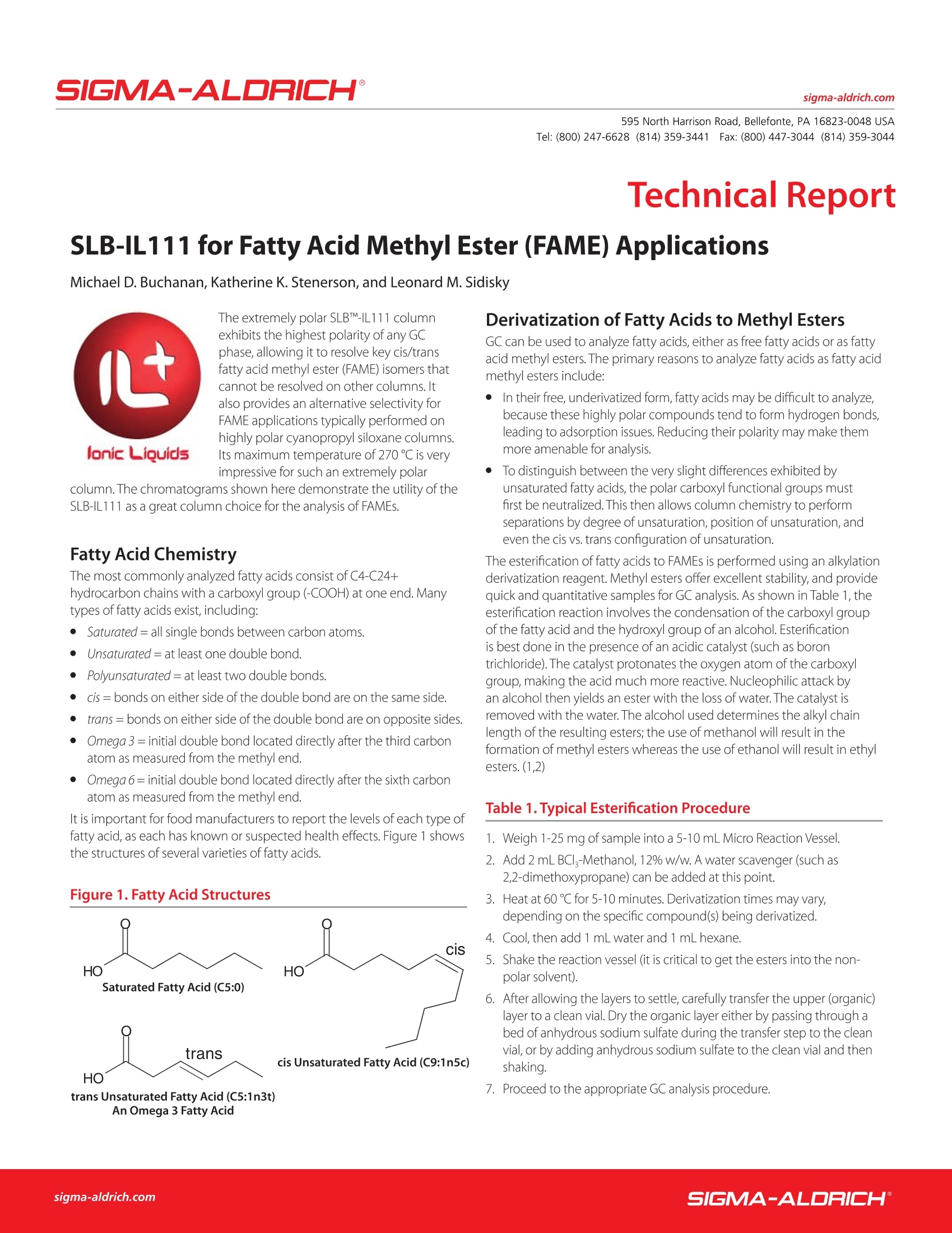

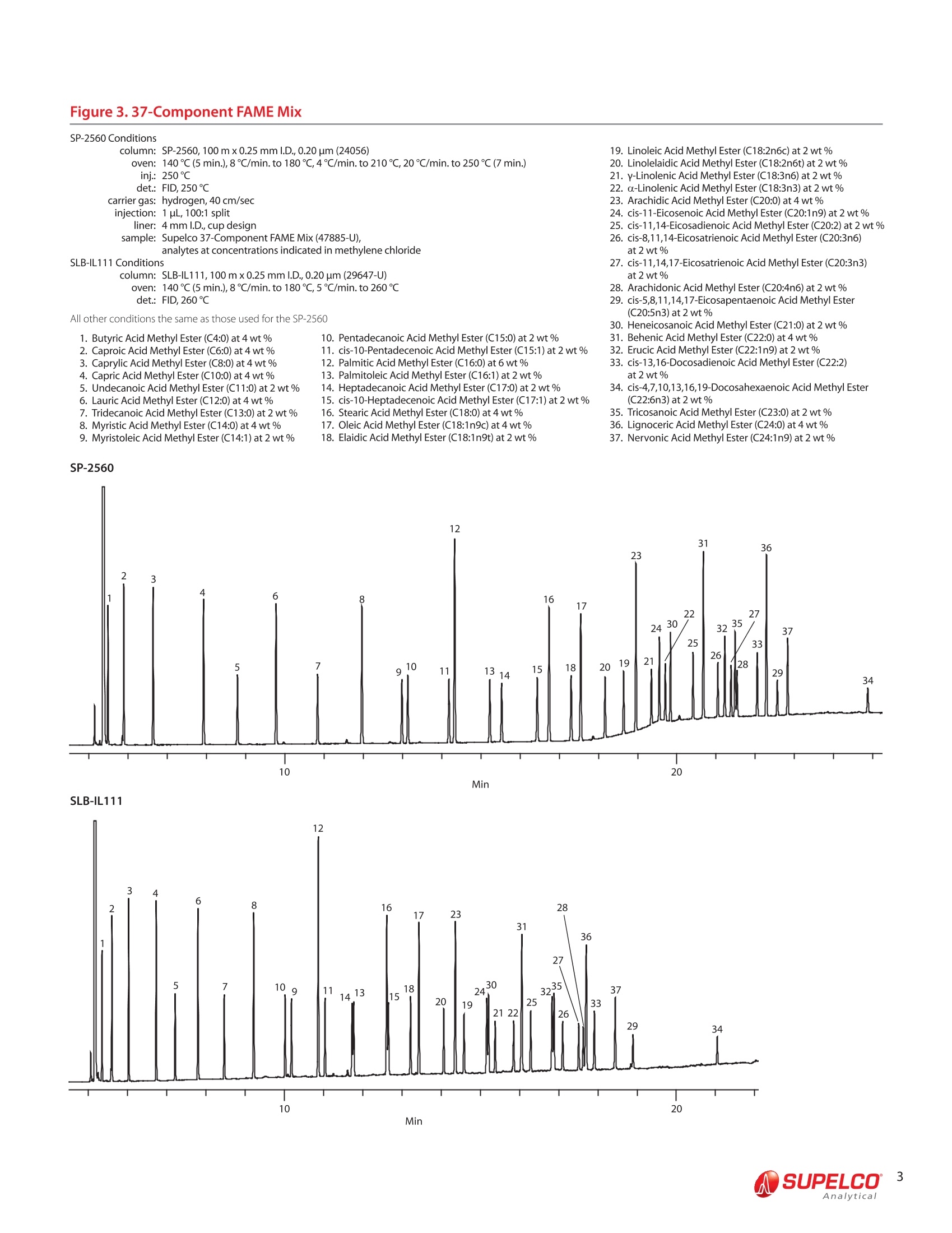



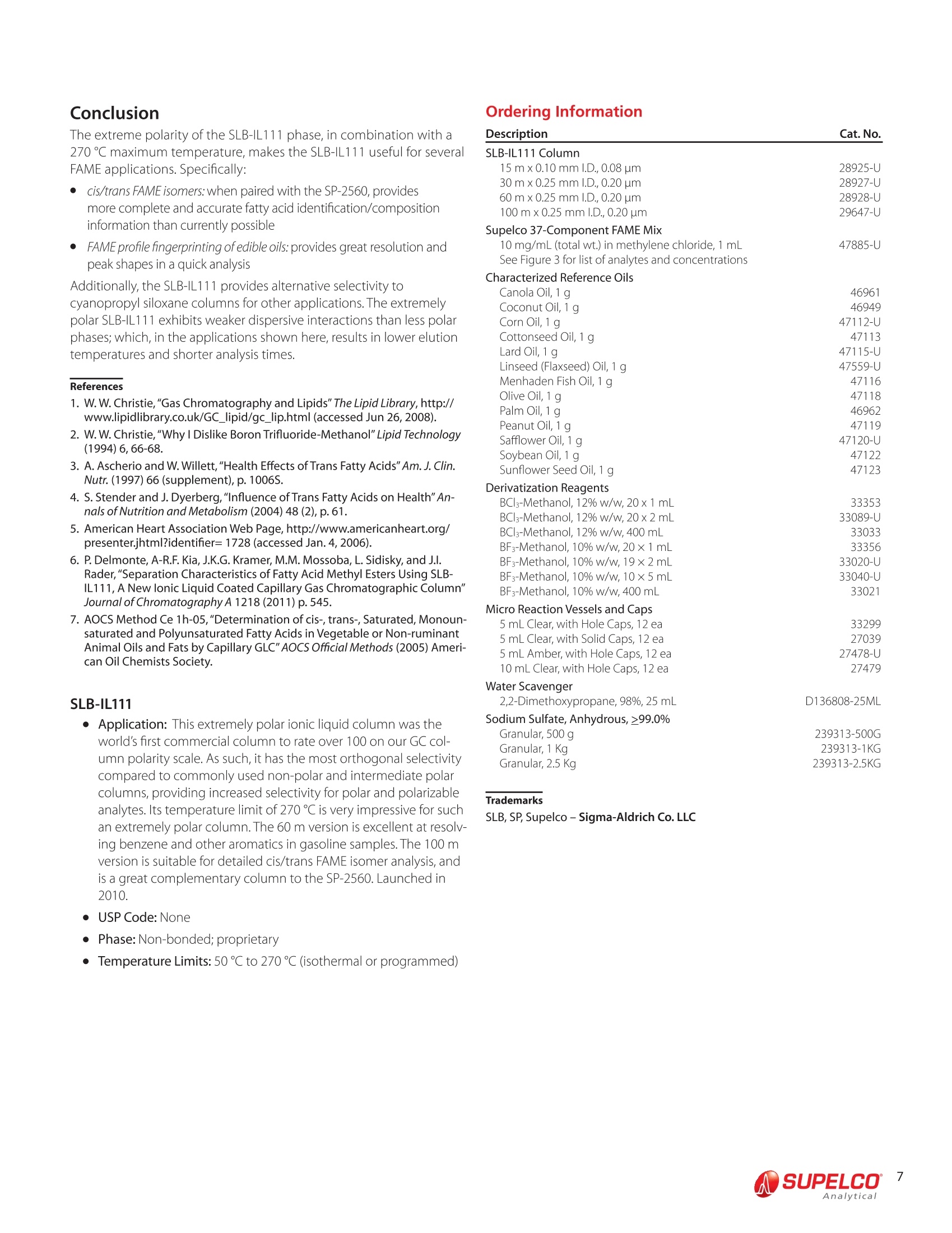
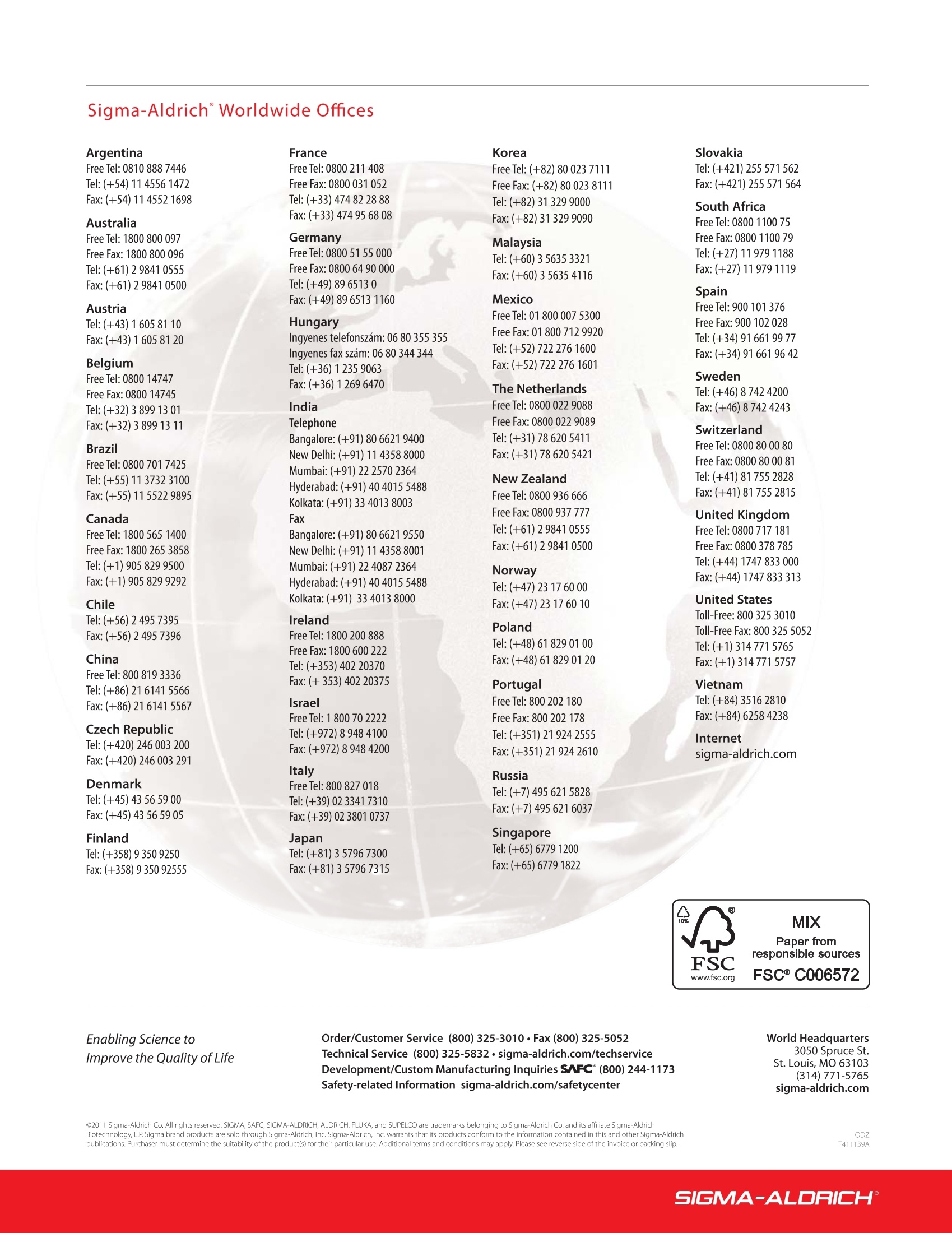
还剩6页未读,是否继续阅读?
默克化工技术(上海)有限公司为您提供《SLB-IL 111用于脂肪酸甲酯的分析——效果优于SP-2560》,该方案主要用于食用植物油中脂肪酸甲酯检测,参考标准--,《SLB-IL 111用于脂肪酸甲酯的分析——效果优于SP-2560》用到的仪器有默克 Supelco® 加热块,21mm(3-5ml微量反应瓶)、37种脂肪酸甲酯混标 (Supelco)、三氟化硼-甲醇
推荐专场
相关方案
更多
该厂商其他方案
更多

